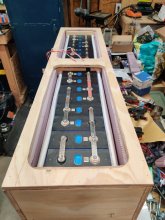I was originally planning to use the exact same RV heating pad you had used in your heater. After seeing the issues you had I reverted back to one of the alternate plans I had. Im now using the same thermostat you had promoted in your thread but am using 4 120W silicone heating pads instead. The two on either ends of the bank will be wired in series so each of those pads will be good for 30W and then two in the middle can be off or on with the outside two and will be switchable series or parallel so If its -30 out and I have let it everything cool down but decide to go out on short notice. I can switch them to parallel and heat everything up a lot faster.The source I used for my warming pads said that RV water tank heaters are the wrong type to use for batteries. They'll get too hot. RV water tank heaters are based on heating a plastic tank with water in it. You have metal cell walls with electrolyte inside.
These are the pads I have on order: https://www.amazon.ca/gazechimp-Sil...w+silicone+heating+pad&qid=1612496540&sr=8-25



